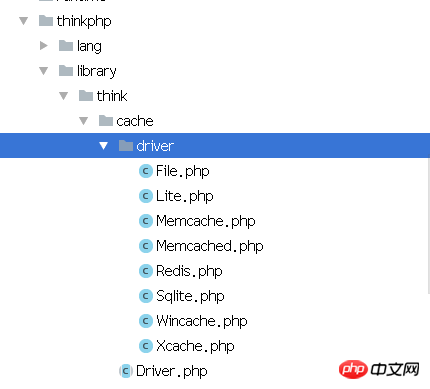
在当今大流量的互联网之中,Cache的重要性不言而喻。ThinkPhp5作为国内主流框架,提供了强大的Cache功能。让我们跟随本文,来剖析TP5 Cache的原理及使用。
为什么需要Cache(缓存)?
假设现在有一个小说网,有非常多的读者,有一篇新的章节更新了,那么可能一分钟内有几万几十万的访问量.
如果没有缓存,同样的内容就要去数据库重复查询,那可能网站一下就挂掉了.
追求性能的web站点应该充分利用缓存,常见的缓存类型有File,Memcache,Redis等,这里就不说他们的区别了
今天我们分析下TP5 Cache的内部实现原理.
首先看官方文档如何使用缓存的.

如上图,调用Cache类的的静态方法set就可以直接使用了,我们查看Cache类文件 在application/thinkphp/library/think目录下
protected static $instance = [];
public static $readTimes = 0;
public static $writeTimes = 0;
/**
* 操作句柄
* @var object
* @access protected */
protected static $handler; /**
* 写入缓存
* @access public
* @param string $name 缓存标识
* @param mixed $value 存储数据
* @param int|null $expire 有效时间 0为永久
* @return boolean */
public static function set($name, $value, $expire = null)
{
self::$writeTimes++;
return self::init()->set($name, $value, $expire);
}看到原来set方法是这样的, 其中writeTimes 是Cache类的静态变量,主要记录缓存的读取次数,这不是重点.
注意到了吗,有个静态变量命名为 $instance, 上次说过这样命名大概率就是 单例模式了.
set方法的重点是init方法
我们再看init方法
public static function init(array $options = [])
{ if (is_null(self::$handler)) { // 自动初始化缓存
if (!empty($options)) {
$connect = self::connect($options);
} elseif ('complex' == Config::get('cache.type')) {
$connect = self::connect(Config::get('cache.default'));
} else {
$connect = self::connect(Config::get('cache'));
}
self::$handler = $connect;
} return self::$handler;
}handler就是操作的句柄(巨饼:-) ), 这里一看,果然是单例模式了,如果句柄为空才去初始化对象,不然直接返回.句柄
同样,这里重点是connect函数, 传入的参数是 配置信息
同样,我们查看connect方法
/**
* 连接缓存
* @access public
* @param array $options 配置数组
* @param bool|string $name 缓存连接标识 true 强制重新连接
* @return Driver
*/
public static function connect(array $options = [], $name = false)
{
$type = !empty($options['type']) ? $options['type'] : 'File';
if (false === $name) {
$name = md5(serialize($options));
}
if (true === $name || !isset(self::$instance[$name])) {
$class = false !== strpos($type, '\\') ? $type : '\\think\\cache\\driver\\' . ucwords($type);
// 记录初始化信息
App::$debug && Log::record('[ CACHE ] INIT ' . $type, 'info');
if (true === $name) {
return new $class($options);
} else {
self::$instance[$name] = new $class($options);
}
}
return self::$instance[$name];
} self::$instance[$name] = new $class($options); 这一句里,我们就可以知道句柄的真实身份拉,
$class = false !== strpos($type, '\\') ? $type : '\\think\\cache\\driver\\' . ucwords($type);
这一句的意思是class的名字由type决定, 如果type没有包含反斜线, 则class = \think\cache\driver\.ucwords($type)
thinkPhp 是把think作为核心目录的别名的,所以他真实路径就是 \thinkphp\libray\\think\driver\.ucwords($type)
根据自动加载的尿性,自然是去该文件夹下加载对应的对象
(额外提一句,这利用的是PHP动态变量的一个特性,其实就和工厂模式一个原理,运行中动态决定实例化的对象)
type是什么呢? type就是函数传入的参数,也就是配置信息,我们看下配置信息 type就是驱动方式,如果我们type填写的是File,那么就使用文件驱动,实例化的是 \think\cache\driver\File.class
type就是驱动方式,如果我们type填写的是File,那么就使用文件驱动,实例化的是 \think\cache\driver\File.class
我们看下 \think\cache\driver文件下有什么文件,那就知道thinkphp为我们提供了多少种缓存驱动了

原来有这么多!
点进去
每个文件,我们可以发现一个共同点, 每个类都是继承了 抽象类 Driver
Driver决定了 每一个Cache驱动应该是什么样子的,他们的方法基本是一样的,而实现方式因每个驱动不同而异
其实这就是 适配器模式,如果是我们自己写,当然不会写那么多拉,不过TP5是为了造福广大PHP开发者,所以编写了那么多不同的驱动供我们使用.
我们重点看Redis吧, 如果要去实验,记得把 config中的 Cache.type更改为 redis
Redis类的方法很少,先看看构造函数
public function __construct($options = [])
{
if (!extension_loaded('redis')) {
throw new \BadFunctionCallException('not support: redis');
}
if (!empty($options)) {
$this->options = array_merge($this->options, $options);
}
$func = $this->options['persistent'] ? 'pconnect' : 'connect';
$this->handler = new \Redis;
$this->handler->$func($this->options['host'], $this->options['port'], $this->options['timeout']);
if ('' != $this->options['password']) {
$this->handler->auth($this->options['password']);
}
if (0 != $this->options['select']) {
$this->handler->select($this->options['select']);
}
}可见TP5的 redis驱动 是基于phpredis的阿, handler 就是实例化的phpredis类, 因此选了哪个驱动,Cache的类自然就是哪些驱动.
所以说如果要使用 TP5的 redis,必须要先安装phpredis扩展.
这里就顺便解析下 redis重写的 set方法
/**
* 写入缓存
* @access public
* @param string $name 缓存变量名
* @param mixed $value 存储数据
* @param integer $expire 有效时间(秒)
* @return boolean
*/
public function set($name, $value, $expire = null)
{
if (is_null($expire)) {
$expire = $this->options['expire'];
}
if ($this->tag && !$this->has($name)) {
$first = true;
}
$key = $this->getCacheKey($name);
//对数组/对象数据进行缓存处理,保证数据完整性 byron sampson<xiaobo.sun@qq.com>
$value = (is_object($value) || is_array($value)) ? json_encode($value) : $value;
if (is_int($expire) && $expire) {
$result = $this->handler->setex($key, $expire, $value);
} else {
$result = $this->handler->set($key, $value);
}
isset($first) && $this->setTagItem($key);
return $result;
}原本的phpredis set方法 只能是 普通的键值对, 而重写的set方法现在可以是 键,数组啦,这是非常有用的方法
可以看到实现的 原理是把 数组或者对象 序列化为json, 取值的时候则反序列化成为数组.
到这里我们就基本分析完了一个驱动是如何实现的,首先必须 继承Driver类,实现Driver规定的方法,然后将handler交给Cache类去使用
我们回到Cache类

可以看到Cache类调用函数的方法基本斗是这样, init()获取 到handler,然后操作handler对象,也就是我们真正的 操作对象,这里就是 phpredis类啦,
当然我们是没办法直接操作 phpredis类的, 只能使用Cache类 的寥寥几种方法,所以有些人不满意,因为队列,集和,哈希都认为没办法使用了,我也在网上看到有些同学 重写TP5的 redis类
其实大可不必, Cache类还是暴露了一个接口给我们的.
我们可以这样
$res = Cache::init();
$redis = $res->handler();
$redis->lpush('test',111);
$redis->rpush('test',111);
$redis->lpop('test');获得了 handler 也就是获得了 phpredis,这样就可以随便使用 phpredis原生的方法啦,而且还是单例模式哦, 没有新建对象额外的消耗
本文就到这里结束啦, 如果要知道更多Cache类的使用方法,可以按上文的方式直接看源代码,或者再去查阅官方文档.
虽然没有讲解如何使用,但是分析了 Cache的实现原理有助于提高我们的编程抽象水平, 上文分析源码的方式也同样可以用来分析其他的核心类库.
相关阅读:
The above is the detailed content of The principle and use of TP5 Cache. For more information, please follow other related articles on the PHP Chinese website!




